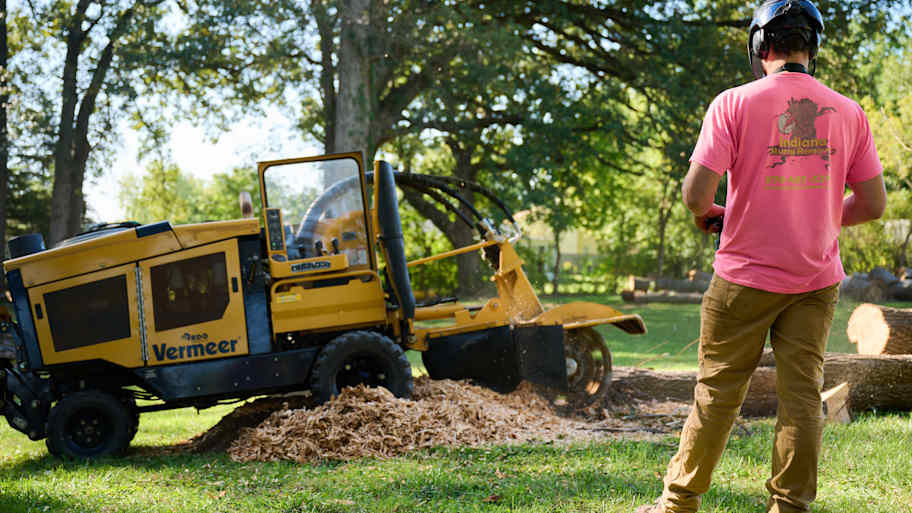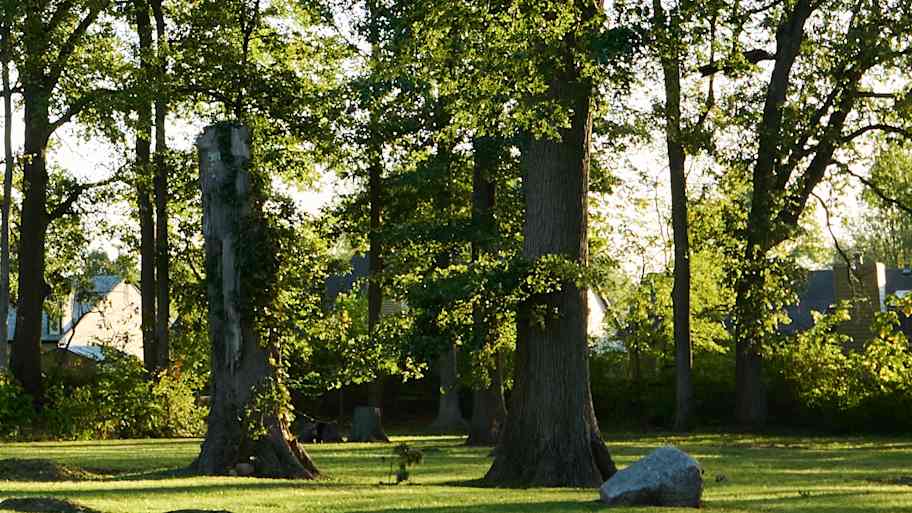How to Plant Palm Trees: 7 Steps to Success
Set up your palm tree for success


- Shovel
- Trowel
- Garden hose
- Plenty of water
- Palm fertilizer
- Garden or potting soil
- Sand (optional)
Nothing transforms a backyard into a garden oasis like a palm tree. Learning how to plant a palm tree is an essential step to ensure it establishes a healthy base, promoting long-term growth. Our guide on planting a palm will walk you through the most important steps, including the type of fertilizer to use, what soil a palm needs, how large to dig the hole, and how to water a newly-planted palm tree.
Prepping to Plant Palm Trees
Follow these planting prep steps to set your palm tree up for success.
Pick Your Palm Species
Like all home projects, planting a palm tree works better when you start with a little research. Determine what kind and size of palm tree to plant, considering your yard size and climate. A few common options include:
Parlor palm: This palm tree variety loves shade but cannot survive outside of a tropical or subtropical environment.
Sable palm: This palm is popular for colder weather found in places like Nevada or North Carolina.
Queen palm: This species loves very hot weather and sun.
Needle palm: Needle palms are some of the most cold resistant varieties and survive in areas where other palms can’t live.
Chinese fan palm: This bushy palm is known for its low height and broad fronds.
Once you have the palm species picked, research its requirements for healthy growth. Note that palm trees can be quite demanding when it comes to soil type. Most palms need loose, sandy soil that drains well.
Purchase Palm Fertilizer (and Possibly Sand)
Your next preparation step is getting the right palm fertilizer. While palm trees favor loose, sandy soils, that type doesn’t have many nutrients, so it’s important to give your new palm a helping hand. Look for an NPK value of around 12-4-12, specifically a slow-release formula for palm trees.
If you have hard or compacted soil, you may be able to make it suitable for a palm tree by mixing it with sand as you backfill. This isn’t a remedy for every type of soil, but it can help for soils that need to be more loose and faster-draining. If you don’t have any compost or potting soil handy, it’s a good idea to buy a bag of that as well.
Transport and Prep Your Palm
Arrange to have your palm delivered if necessary, or pick it up and take it home. Try to plan your planting for the same day or within a day or two, since leaving the palm above ground for an extended period of time is harmful to it.
If the palm isn’t in a pot, make sure the root ball is wrapped in burlap and kept wet. Keep the palm in the shade and out of direct light. When you are ready to plant the palm tree, uncover the root ball and soak it in a bucket of water.
How to Plant Palm Trees
Picking and purchasing a palm tree is a big decision, and the first few days of planting and care are vital to ensuring your palm will last for decades. Follow these steps to plant your palm tree.
Dig a Hole Carefully
 Photo: Eerik / iStock / Getty Images Plus / Getty Images
Photo: Eerik / iStock / Getty Images Plus / Getty ImagesWhile some palm trees like the shade, you should place most varieties in sunny locations. Start by digging a hole that’s twice the width of the palm tree’s root ball, and a couple of inches deeper. Be wary of any irrigation or other pipes underground. Call 811 before digging into your property to eliminate any safety hazards.
If you have thick soil that you plan on loosening with sand, it’s a good idea to dig several inches deeper, and fill that space with a thick layer of sand. Then, add a handful or two of fertilizer to the hole. Mix it all along the bottom and sides until it’s thoroughly incorporated.
Place the Root Ball
Take the palm tree and its soaked root ball and bring it to the hole. Take a couple of minutes to loosen the roots slightly and uncoil any roots that are wrapped around each other. Be very gentle with the roots to avoid any incidental damage. Ideally, the primary root ball clump of roots and dirt will remain intact.
Place the root ball in the hole and center it. The palm tree should be about at the level it was in the pot, but not deeper (which is bad for the trunk). No roots should be exposed above ground level. At this point, it’s useful to have another person stabilize the root ball while you work on backfilling.
Slowly Backfill with Soil
Mix the emptied soil with sand. If you aren’t using sand, you can mix it with compost or with packaged garden soil to make it as healthy as possible. Slowly backfill the hole by hand, keeping the palm tree level. Use your hose to apply water from time to time.
You don’t want to compact the soil, but you also want to remove any air pockets around the root ball. Once you reach ground level, build up a circular mound of soil around the tree, but avoid letting the soil contact the trunk.
Stake the Palm Tree, If Necessary
Young palm trees may need extra support when first planted, especially if they are tall and spindly. This is a good time to stake your tree or use wraps, bands, or string to support the palm tree and protect it against the wind. You can remove these supports in a year or two as the tree grows.
Set Up a Sprinkler Schedule or Watering Plan

Water the tree thoroughly when you finish the planting process. Set your sprinkler schedule to water the palm every day for the next couple of months. Ideally, you’ll have a couple of bubbler sprinkler heads near the palm tree that can water it at a rate of around two to three gallons per minute.
Otherwise, you can water by hand every day so the palm gets enough water. Watch for browning tips on palm fronds, which is a sign the palm tree isn’t getting enough water.
Add Mulch Around the Base
 Photo: ronstik / iStock / Getty Images Plus / Getty Images
Photo: ronstik / iStock / Getty Images Plus / Getty ImagesMulch is not a requirement for a successful palm planting, but it is a good idea to promote healthy growth. Add a layer of mulch around the palm tree, making sure to not pile it up around the trunk. This step is especially important if you have a cold-hardy palm and need it to survive cool winters.
Add Fertilizer
After about three months, preferably when the palm is at the height of its growing season, add a layer of slow release fertilizer around the tree and give it an extra-deep watering. At this point, you can start easing off on the daily watering and develop a less frequent watering routine, again watching the palm for any signs of problems. Now your palm is well on the way to a healthy life.
DIY vs. Hiring a Pro
In most cases, you can DIY a palm tree planting, especially if you have a couple of extra hands to help out. With the right preparation and tools, you can manage the transplant details and steps on your own.
However, there are some cases when hiring a local palm tree pro is recommended. The big one is size: Palm trees, especially adult varieties, are big and their root balls are heavy. Not everyone will be able to transport and move the palm tree on their own, or get enough help to plant it. A palm tree costs $250 on average, but hiring a tree-planting professional to place it in your yard will cost $50 to $150 per hour for labor.
Frequently Asked Questions
You can overwater a palm tree. While palm trees are famous for needing plenty of water, especially right after you plant them, they can be overwatered. That’s especially true if you plant a palm tree in thick soil that holds lots of water, which palm trees aren’t well-suited for. Many domesticated palm trees die from overwatering. Palms should be planted in fast-draining soils and watered around one to two gallons per minute when first planted.
Palm trees prefer tropical and subtropical climates, thriving between consistent 60 to 80 degree Fahrenheit weather. If you live in a colder climate, you can still plant a palm tree but you’ll have to take extra care of it if the weather drops below 50 degrees. If cold weather reaches freezing temperatures in your area, it’s unlikely a palm tree will survive long outdoors.
For more information, every palm species should have USDA climate zone advisories, often printing directly on their labels, which you can use to make specific choices.
The claim that palm trees need Epsom salt stems from a palm tree’s need for a certain amount of magnesium in the soil without which the palm will start to yellow and die. Epsom salt is rich in magnesium and relatively harmless, so it can be used as an additive to the soil around a palm tree to help it recover. Ideally, palm trees will get the magnesium they need for an early dose of fertilizer in healthy, sandy soil before reaching this point.














